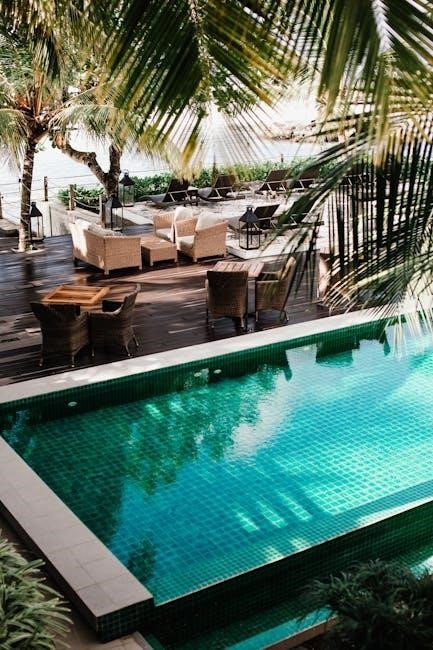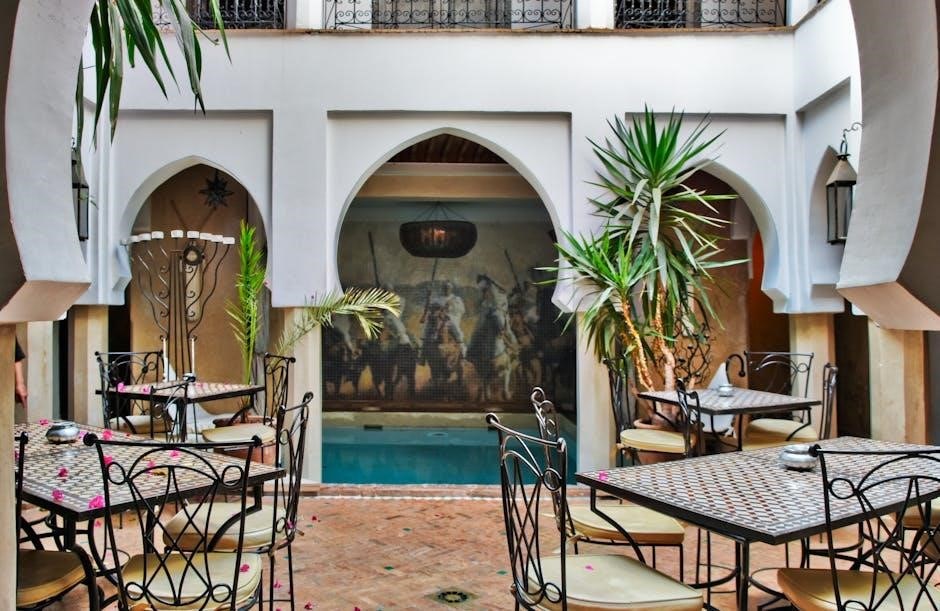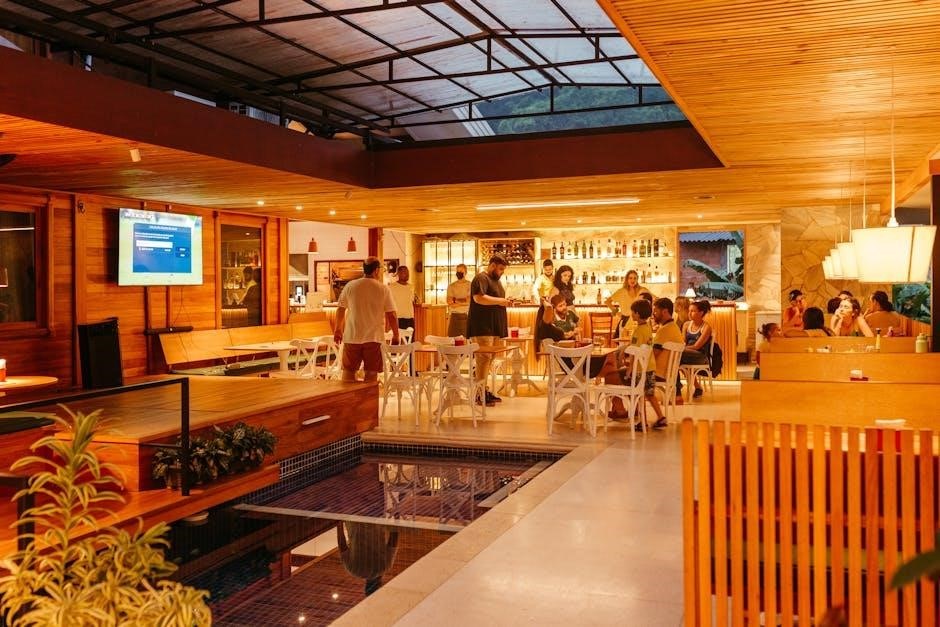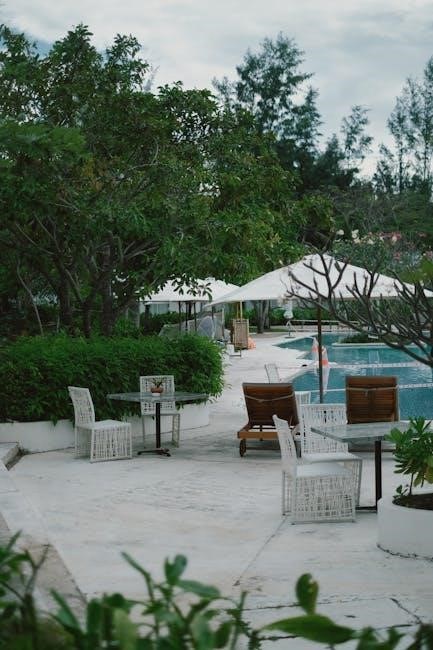Pool table size is crucial for optimal gameplay and space utilization. Standard sizes range from 7 to 9 feet, with 9×4.5 feet being the professional standard. Understanding dimensions helps choose the right fit for home, bars, or tournaments, ensuring enjoyable and competitive play.
Why Pool Table Size Matters
Pool table size significantly impacts gameplay, as it affects shot accuracy, ball movement, and overall playing experience. A table that is too small or too large can lead to a less enjoyable game. Proper sizing ensures balanced play, catering to both casual and competitive players. For professional settings, adhering to standard sizes is essential for maintaining consistency and fairness in tournaments. Additionally, table size influences room layout, as insufficient space can hinder movement and comfort during play. Choosing the right size ensures optimal performance and enjoyment, making it a critical decision for both home and commercial use.
Overview of Standard Pool Table Dimensions
Standard pool table dimensions typically range from 7 to 9 feet in length, with widths proportionally sized to maintain playability. The most common sizes include 7-foot, 8-foot, and 9-foot tables, each catering to different settings and skill levels. A 7-foot table is ideal for casual play in smaller spaces, while 8-foot tables are popular for home use, offering a balance between size and accessibility. The 9-foot table, measuring 9×4.5 feet, is the professional standard, often used in tournaments for its larger playing surface. Understanding these dimensions helps in selecting a table that fits both the room and the intended use, ensuring optimal gameplay and enjoyment.
Standard Pool Table Sizes

Standard pool tables range from 7 to 9 feet in length, with widths proportionally sized. The 9-foot table (9×4.5 feet) is the professional standard, while 8-foot tables are most common in homes, and 7-foot tables are ideal for casual play in smaller spaces.
7-Foot Pool Tables
A 7-foot pool table is a popular choice for casual play and smaller spaces. Its compact size makes it ideal for home use, fitting neatly into basements or game rooms. The playfield typically measures 38 inches by 76 inches, offering a fun experience without requiring extensive space. This size is perfect for recreational players and families, as it allows for enjoyable gameplay without the formalities of larger tables. However, it’s important to note that 7-foot tables are not used in professional tournaments, making them less suitable for serious players. Despite this, their affordability and space-saving design make them a favorite for many homeowners.
8-Foot Pool Tables
An 8-foot pool table is the most common size sold in the U.S. for home use, offering a balance between space efficiency and gameplay experience. The playfield measures 44 inches by 88 inches, making it ideal for smaller rooms while still providing a challenging and enjoyable experience. This size is popular for its versatility, catering to both casual players and those with intermediate skills. It’s a practical choice for homeowners who want a table that fits well in their space without sacrificing playability. The 8-foot table strikes a perfect middle ground between the compact 7-foot and the larger 9-foot models, making it a favorite for many residential settings.
9-Foot Pool Tables

A 9-foot pool table is the professional standard, commonly used in tournaments and serious gameplay. Its playfield measures 50 inches by 100 inches, providing ample space for precise shots and strategic play. This size is ideal for skilled players and those who aim to improve their techniques. It’s the original size on which billiards was invented, offering a classic and authentic experience. However, it requires a larger room to accommodate both the table and comfortable play. The 9-foot table is a favorite in commercial settings like bars and clubs, as well as for enthusiasts who have the space to dedicate to their passion for the game.

Tournament and Regulation Sizes
Tournament and regulation pool tables adhere to strict size standards, ensuring consistency and fairness in competitive play. The 9-foot table is the professional tournament standard, providing a larger, challenging surface for skilled players and official events.
Professional Tournament Standards
Professional tournament standards require precise pool table dimensions to ensure fair and consistent play. The official size for professional tournaments is a 9-foot table, measuring 9 feet long and 4.5 feet wide. This larger surface accommodates advanced techniques and higher speeds, making it ideal for skilled players. Tables used in professional settings are typically made of high-quality materials, such as slate, to provide a smooth and even playing surface. Additionally, the cloth and cushion quality are tightly regulated to maintain consistent ball behavior. These standards ensure that players compete on equal terms, fostering a competitive and unbiased environment for all participants.
Regulation Table Dimensions
Regulation pool tables must meet specific size requirements to ensure consistent play. The standard playfield dimensions for regulation tables are 50 inches wide and 100 inches long, making the overall table size 9 feet by 4.5 feet. These measurements are strictly adhered to in professional and tournament settings to maintain fairness and consistency. The table’s rails and pockets are also standardized, with pockets sized to accommodate the balls and ensure accurate gameplay. Regulation tables are typically made of high-quality materials, such as slate, to provide a smooth and durable playing surface. These dimensions and materials ensure optimal performance and are essential for competitive play.
Pool Table Room Size Guide
Choosing the right room size for your pool table ensures comfortable play. Consider table size, cue length, and player movement to determine optimal space requirements for enjoyable gameplay.
Minimum Room Dimensions for Pool Tables
When selecting a pool table, ensure your room meets minimum size requirements for comfortable play. For a 7-foot table, the room should be at least 13 feet by 16 feet. An 8-foot table requires a room of 13 feet by 17 feet, while a 9-foot table needs a larger space of 14 feet by 18 feet. These dimensions account for cue stick length and player movement. Adding 2-3 feet around the table ensures ample clearance. Proper room size enhances gameplay and prevents obstacles, making it essential to measure accurately before installation.
Calculating Space for Comfortable Play
Calculating space for comfortable play involves considering the table size, cue stick length, and player movement. Add 2-3 feet to each side of the table for cue clearance and 4-5 feet at each end for shooting comfort. For example, a 9-foot table requires 14 feet in length and 12 feet in width. Measure doorways and hallways to ensure the table fits. Proper space ensures smooth gameplay and prevents obstacles. Plan the layout to accommodate seating and spectator areas if needed. Accurate measurements guarantee a enjoyable and obstacle-free playing experience, making it essential to assess your room thoroughly before installation.

Factors to Consider When Choosing a Pool Table Size
Consider room size, skill level, and intended use. Measure space accurately, ensuring comfort for players. Choose size based on frequency of play and personal preference for optimal enjoyment;

Skill Level and Playing Style
Your skill level and playing style significantly influence the ideal pool table size. Casual players may prefer smaller tables like 7-foot models for easier shots and recreational play. Intermediate players often opt for 8-foot tables, offering a balance between space and challenge. Advanced players or professionals typically choose 9-foot tables, the standard for tournaments, as they demand precision and strategy. Consider how often you play and your long-term goals. Smaller tables accommodate tighter spaces but may limit skill development. Larger tables provide a more authentic experience, mirroring professional settings. Match the table size to your expertise and aspirations for an enjoyable and rewarding gameplay experience.
Frequency of Use and Durability

Frequency of use and durability are key factors in choosing a pool table size. Heavy-use tables, like those in bars or clubs, require sturdy construction to withstand constant play. Home tables, used less frequently, can prioritize size over extreme durability. Slate tables are more durable than wood, with thickness affecting longevity. Regular maintenance, such as cleaning and covering, extends table life. For frequent use, opt for high-quality materials and larger sizes to handle wear and tear. Balancing size, material quality, and maintenance ensures your table remains in great condition for years, whether for casual play or intense competition.

Pool Table Size for Different Settings
Pool table size varies by setting, with 7-8 foot tables suiting homes and 9-foot tables preferred for professional venues, ensuring optimal play and space utilization;
Home Use: Finding the Right Fit
For home use, pool table size depends on available space and personal preference. A 7-foot table is ideal for smaller rooms, while an 8-foot table suits medium-sized areas. Measure your room carefully, ensuring at least 4-5 feet of clearance around the table for comfortable play. Consider the frequency of use and skill level; casual players may prefer a 7-foot table, while serious enthusiasts might opt for an 8-foot. Durability and material quality are also important for long-term enjoyment. Choosing the right size ensures a perfect balance between functionality and fun, making your home pool table a centerpiece for entertainment and relaxation.
Commercial Use: Bar and Club Sizes
In commercial settings like bars and clubs, pool table size is chosen to accommodate high traffic and diverse player preferences. A 9-foot table is often preferred for its professional feel and ability to host tournaments, while 8-foot tables are also popular for their balance between playability and space efficiency. Bars with limited space may opt for 7-foot tables, which are more compact yet still provide an enjoyable experience. Durability is key in commercial environments, as tables must withstand frequent use. Larger tables enhance the gaming atmosphere, making them a staple in entertainment venues. Choosing the right size ensures customer satisfaction and a lively, competitive environment.
Measuring Your Pool Table
Measuring your pool table involves determining the playfield dimensions and adding rail sizes. Standard sizes include 7, 8, and 9 feet, with specific measurements for each.
Understanding Table Dimensions
Pool table dimensions are measured from the outer edges, including the rails and pockets. Standard sizes range from 7 to 9 feet in length and 3.5 to 4.5 feet in width. The playfield, the actual playing area, is smaller, typically 2 inches less on each side due to the rails. For example, a 7-foot table has a 39-inch by 78-inch playfield, while a 9-foot table measures 50 inches by 100 inches. Accurate measurements are essential for ensuring the table fits your space and meets regulatory standards for tournaments or professional play. Understanding these dimensions helps in selecting the right size for your needs and skill level.
How to Measure Your Room
To ensure your pool table fits comfortably, measure your room’s length and width in feet. Add 5 feet to the table’s length and 3 feet to its width for cue stick clearance. For example, a 9-foot table requires a room at least 14 feet long and 12 feet wide. Consider doorways, obstructions, and player movement. Use a tape measure to check diagonal spaces if moving the table through tight areas. Ensure the room is square or rectangular for optimal placement. Double-check measurements to avoid sizing errors. Properly measuring your space guarantees a perfect fit and enjoyable gameplay for years to come.
Pool Table Size and Maintenance
Pool table size affects maintenance, as larger tables need more space for cleaning and upkeep, ensuring optimal performance and longevity with regular care and proper spacing.
Caring for Different Sized Tables

Proper maintenance is essential for all pool table sizes. For smaller 7-foot tables, regular cleaning and cloth conditioning ensure smooth play. Medium 8-foot tables require attention to cushion rubber and pocket alignment. Larger 9-foot tables, often used in professional settings, need meticulous care to maintain tournament-level performance. Regardless of size, consistent upkeep, such as brushing the felt and checking cushion tightness, is crucial. Proper storage of cues and balls near the table helps maintain organization. Regularly inspecting the table’s frame and legs ensures stability. By tailoring care to the table’s size, players can extend its lifespan and ensure optimal gameplay quality.
Upkeep Tips for Optimal Performance
Regular upkeep ensures your pool table performs at its best. Clean the felt surface with a brush and mild detergent to prevent dust buildup. Check cushion tightness and alignment to maintain consistent ball bounce. Inspect the pockets for wear and tear, replacing damaged rubber as needed. For larger tables, professional leveling is recommended to ensure even play. Store cues and balls in a dry area to prevent warping. Avoid placing drinks or heavy objects on the table to protect the finish. Use high-quality cleaning products designed for pool tables to maintain the cloth’s texture and color. Consistent maintenance extends the table’s lifespan and enhances gameplay quality.
Choosing the right pool table size ensures optimal gameplay and space efficiency. Consider standard sizes, room dimensions, and personal preferences for a perfect fit and enjoyable experience.
Final Thoughts on Choosing the Right Size
Selecting the ideal pool table size involves balancing space, skill level, and usage frequency. For casual play, a 7-foot table is suitable, while serious players prefer 9-foot models. Professional settings often require regulation sizes, ensuring consistency. Measure your room carefully, adding extra space for comfortable cue movement. Durability and maintenance needs vary with table size, so consider these factors for long-term satisfaction. Ultimately, the right size enhances gameplay and enjoyment, making it worth the time to evaluate your specific needs and preferences before making a decision.
Recap of Key Considerations
When selecting a pool table, consider room size, player skill, and intended use. Measure your space to ensure the table fits comfortably, leaving enough room for cues. Standard sizes range from 7 to 9 feet, with 9-foot being professional standard. For casual play, 7 or 8-foot tables are ideal, while serious players prefer larger sizes. Durability and maintenance needs vary with size, so choose materials and construction wisely. Assessing these factors ensures the right fit for your needs, enhancing gameplay and enjoyment. Proper planning leads to a satisfying purchase and years of enjoyable play.
